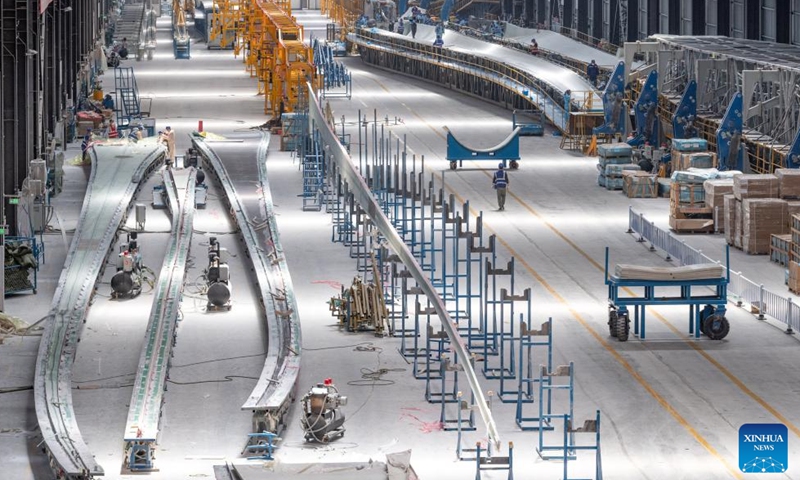China to take multi-pronged approach to build self-sufficient industrial chain

China will take a multi-pronged approach to improve the new system for mobilizing resources nationwide to boost the overall performance of our country's innovation system while also building a self-supporting and risk-controllable industrial chain, especially in key industrial chains such as integrated circuits, industrial machine tools, industrial software, and advanced materials, according to a resolution on further deepening reform comprehensively to advance Chinese modernization that was adopted at the just-concluded third plenary session of the 20th Communist Party of China (CPC) Central Committee.
A detailed version of the resolution was published on Sunday by the Xinhua News Agency under authorization. The adoption of a reform resolution is the most important outcome of the third plenum, which was held in Beijing last week.
The series of measures concerns almost every aspect of technological innovation, including mechanism reform, tech result application, talent development, the leading role of private enterprises as well as policy boosts. Observers said that the top-level design will play a vital role in mobilizing resources and coordinating efforts to spearhead China's technological progress in the years to come, which is consequential amid the US-led blockade, fragmented tech supply chain and cut-throat global tech race. The innovative drives will also underpin the country's march toward the overarching goal of Chinese modernization.
According to the resolution, China will firmly push for deepening scientific and technological structural reform.
The country will optimize the organizational mechanism for key technologies that are placed at "the global frontiers of science and technology, the development of the economy and address major needs of the country," while it will also mount a concerted push for breakthroughs in core technologies in key fields.
It also calls for the establishment risk monitoring, early warning, and response systems to safeguard science and technology security.
It also urged moves to improve the management of science and technology plans to ensure that they are forward-looking and play a guiding role in basic research, interdisciplinary frontier areas, and key fields. The resolution emphasized reinforcing the principal role of enterprises in innovation, and it will back enterprises that volunteer to lead or participate in major national science and technology programs.
With regard to new quality productive forces, the resolution encouraged improving the institutions and mechanisms for fostering new quality productive forces in line with local conditions
Chinese authorities should steer emerging industries toward sound and orderly development, while also improve the policy and governance systems for promoting the development of strategic industries such as next-generation information technology, artificial intelligence, aviation and aerospace, new energy, new materials, high-end equipment, biomedicine, and quantum technology
"We're strongly inspired and encouraged," Yang Yuanqing, chairman and CEO of Lenovo, told the Global Times on Friday, commenting on the resolution.
Measures to further deepen reform comprehensively to advance Chinese modernization will create a sound institutional environment for the high-quality development of the economy, while sparking the vitality of enterprises and enhancing their innovation capacity for the accelerated development of new quality productive forces, Yang said.
"There are multiple positive signals seen in the resolution, for example, in encouraging tech breakthroughs in areas where China is being strangled by Western countries, and in giving private entities more flexibility in undertaking major technological projects. Those measures paint a very promising roadmap for China's homegrown technologies to elevate both security and competitiveness in global arena," Cao Heping, an economist from Peking University, told the Global Times on Sunday.
Wang Peng, an associate researcher with the Beijing Academy of Social Sciences, told the Global Times on Sunday that the parts concerning deepening tech system reform are very problem-oriented. "It gives tech research staffers greater autonomy in the distribution of benefits from the commercialization of scientific and technological results," Wang said.
According to observers, from a long-term perspective, the measures are conducive to building an open innovative ecosystem under which talent is abundant, the integration of industry, academia and research is deep, and the application of technological achievements is moving swiftly.
"It carries great significance at a time when the Chinese economy is undergoing a stage of transforming from a quantity-driven to a quality-driven model, and is set to inject new impetus into the development course," Wang said.
As Western economies have spared no effort to target China's tech rise and the trend is anticipated to deteriorate, Chinese policymakers' priority in ensuring tech sufficiency is also of great importance in shaking off the US-led blockade and cementing a leading position in global tech competition, analysts said.
At a meeting hosted by the Ministry of Science and Technology on Friday to learn about the third plenum, Chinese officials also called for accelerating tech self-reliance and self-strengthening.
"We should strengthen the overall coordination of strategic planning, policy measures, major tasks, scientific research forces, resource platforms and regional innovation….We should fully leverage the foundational and strategic support role of technology in building the Chinese modernization," the meeting said, according to a statement seen on the ministry's website on Sunday.